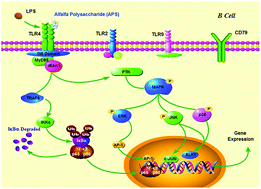A polysaccharide extracted from alfalfa activates splenic B cells by TLR4 and acts primarily via the MAPK/p38 pathway
Abstract
Alfalfa polysaccharide (APS) has been proposed to exhibit growth-promoting and immune-enhancing bodily functions in vivo. However, little is known about its downstream immunomodulatory and intrinsic molecular mechanisms. Herein, mouse splenic lymphocytes were isolated to characterize the immunomodulatory effects and molecular mechanisms of APS in vitro. The results demonstrated that APS selectively improved the cell viability and IgM production of B cells, but no effects on T cell viability or secretion of IL-2, IL-4 and IFN-γ were observed in vitro. The receptor blocking assay showed that TLR4 was the primary receptor involved in APS-mediated B cell activation, which was confirmed by the results obtained using C57BL/10ScNJ (TLR4 gene-deficient) mice. Moreover, APS activated the TLR4–MyD88 signaling pathway at the translational level by significantly increasing the protein expression of TLR4 and MyD88. Downstream pathway blocking assay demonstrated that both the MAPK and NF-κB pathways were involved in APS-induced B cell activation. Additionally, APS significantly enhanced the phosphorylation of p38, ERK, and JNK and activated the nuclear translocation of the NF-κB p65 subunit. Therefore, we concluded that APS specifically activates the immune functions of splenic B cells by TLR4, acting through the MAPK and NF-κB signaling pathways, and potently activates the p38 pathway.



 Please wait while we load your content...
Please wait while we load your content...